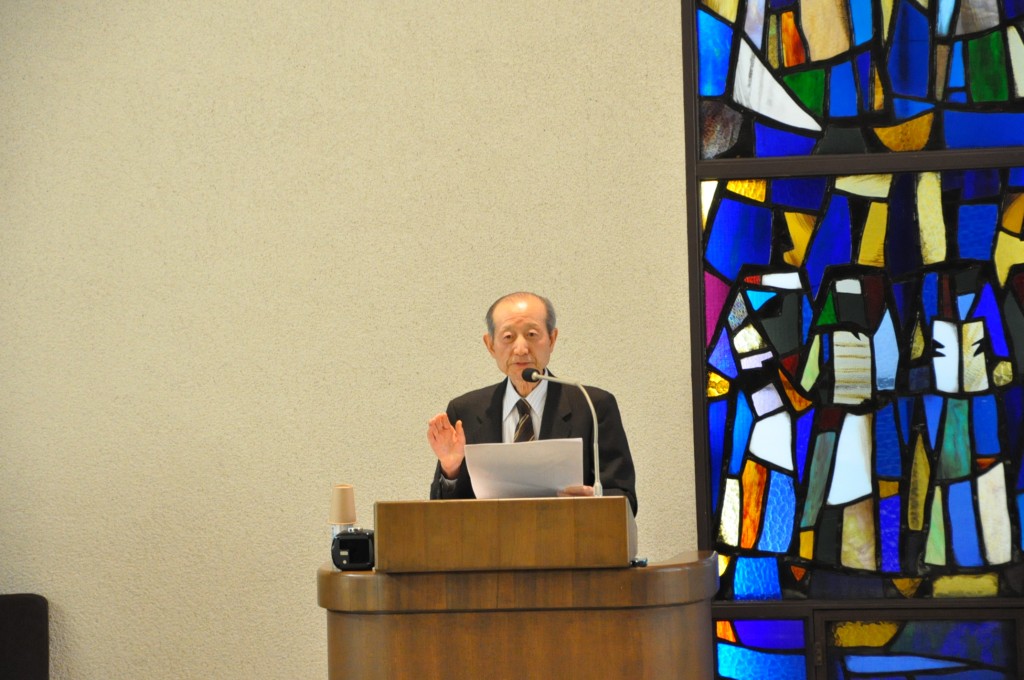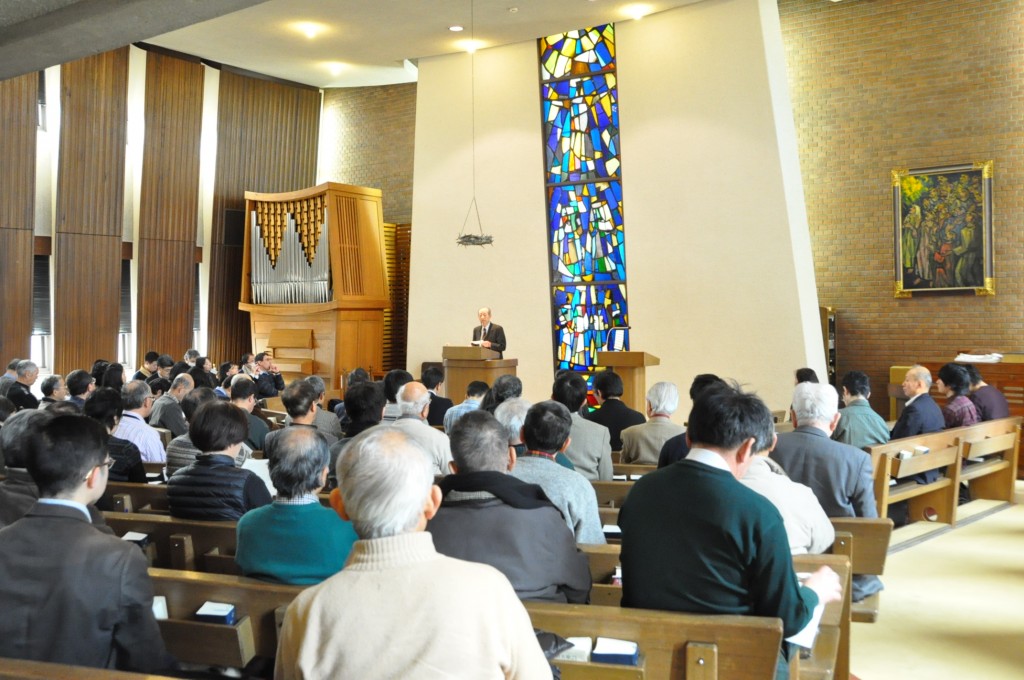Center for Interdisciplinary Study of Monotheistic Religions(CISMOR)Doshisha University
> Public Lectures > Negative views of the Jews in the Japanese newspapers during World War IIPublic Lectures
Negative views of the Jews in the Japanese newspapers during World War II
| Date: |
2014/01/26 13:00-14:15 |
|---|---|
| Place: | Divinity Hall Chapel, Imadegawa Campus, Doshisha University |
| Lecture: | Prof. Masanori Miyazawa (Prof. Emeritus, Doshisha Women’s College) |
| Summary: | |
|
On Sunday, January 26, 2014, CISMOR held an open lecture on the theme “Pro-Nazi newspapers in Showa Wartime Japan, the Increase in Anti-Semitism and People who Oppose This Change.” Referring to many historical documents, the lecturer, Dr. Masanori Miyazawa, Professor Emeritus at Doshisha Women’s College of Liberal Arts, explained how Japanese newspapers began to support the Nazis and anti-Semitism one after another under the wartime regime of the Showa Era (1926-1989). Throughout Japan’s history, relatively few Jewish people have settled in the country. In this sense, we can say that until recently, Japan had been free from the issues concerning the Jewish people. In 1933, the League of Nations inquired of the Japanese government about its policy towards Jewish refugees from Germany. In response, the Japanese government decided to admit their entry into the country with some conditions, as it did for White Russians. Later, in 1938, the Japanese government issued the Guidelines concerning the Treatment of Jewish People, in which it declared that Japan would treat Jewish people fairly and equally with people of other nationalities. The government, however, abolished the Guidelines in 1942, and adopted a new policy that imposed more rigorous conditions on the entry of Jewish people “in response to the changing situation.” Even this new policy, however, differed from the Jewish exclusion policy adopted by Germany and Italy, since the Japanese government decided to treat Jewish people as stateless persons in compliance with the national slogan: Hakko Ichiu (all the world under one roof). However, it was in the Taisho Era (1912-26) that problems concerning Jewish people arose in Japan for the first time in its history. During the Siberian Intervention (1918-22), Japanese military personnel brought home a book The Protocols of the Elders of Zion, which was considered at that time as evidence revealing a Jewish plan for global domination. Some military personnel used the book as a means to suppress the democratic movement in Japan, known as the Taisho Democracy. Referring to The Protocols of the Elders of Zion, they insisted that the democratic movement was fueled by the United States and the United Kingdom, which were manipulated by Jewish people. On the other hand, Sakuzo Yoshino refuted their view, triggering discussions about anti-Semitism. Japanese newspapers, however, seldom picked up this subject. With the beginning of the Showa Era (1926-89) and the emergence of the Nazis, however, Japanese newspapers began to discuss the issue of Jews enthusiastically. Although Japan’s media were critical toward the Nazis when the Nazi Party assumed power in 1933, the press radically changed their attitude in 1935. The turning point was the interview between Hitler and Reiji Kuroda, a correspondent of the Asahi Shimbun newspaper. The front page of the Asahi Shimbun issued on January 27, 1935, was virtually dominated by a report on this interview. Kuroda was the third foreign reporter to whom Hitler granted an interview after his inauguration as the head of state. Their meeting helped build a friendly relationship between the Asahi Shimbun and Hitler. In that year, Japanese journalism, including scholars and opinion leaders who wrote articles for newspapers, changed their attitude toward Germany and Hitler, and began to praise them. The Osaka Mainichi Shimbun newspaper, for instance, took the initiative in inviting the Hitler Youth. Moreover, it frequently organized lectures and exhibitions on the theme of anti-Semitism. In support of the Tripartite Pact between Japan, Germany, and Italy, Japanese newspapers frequently introduced Hitler’s speeches without any critical comments. At the time of Italy’s surrender to the Allies, one Japanese newspaper argued in its editorial that the bombing of Rome by the United States and the United Kingdom was manipulated by Jewish people and Freemasonry, since free Christian states could not have bombed Rome, a center of Christianity. Some newspapers also introduced views of Japanese military personnel that the surrender of Italy would relieve Hitler of a heavy burden. The newspapers’ inclination towards Nazism also led to anti-Semitism. Japan’s invasion of China was interpreted as a “holy war” to save Japan and the Far East from the influence of Jews and Communism. The newspapers advocated that the Jewish problems were no longer “a fire on the other side of the river,” because China was controlled by the United States and the United Kingdom, which themselves were controlled by Jewish people. Based on the argument that real Japan-China relations could not be understood without recognizing the presence of Jewish people behind the Western powers, the Japanese newspapers advocated that Jewish influence should be eliminated by defeating the United States and the United Kingdom. It was in this environment that Chiune Sugihara, a Japanese diplomat serving in Lithuania, issued transit visas to thousands of Jewish refugees mainly from Germany-occupied Poland. They arrived in Japan in 1940. It was the first time that ordinary Japanese people had encountered a group of Jewish people in person. Japanese newspapers reported this encounter fairly faithfully. There were virtually no articles that reported anti-Semitic behavior by Japanese citizens. The majority of Japanese people were sympathetic to the Jewish refugees, although many might have had a feeling of strangeness towards them. Having direct contact with Jewish people, newspapers stopped fuelling anti-Semitism, even though their reports were sometimes influenced by traditional stereotypes or bias towards Jewish people. After the Jewish refugees left from Kobe to travel to Shanghai, however, Japanese newspaper resumed portraying Jewish people based on traditional stereotypes. Meanwhile, there were a few Japanese who did not align themselves with the trend of supporting the Nazis and anti-Semitism. Kiyoshi Kiyosawa, for instance, vehemently criticized Japanese newspaper and refuted anti-Semitism in his book Ankoku Nikki (lit. The Diary of Darkness). In 1938, when a Jewish refugee was refused entry to Japan from Manchuria (then, Manchukuo), Kiichiro Higuchi persuaded Hideki Tojo, then the most senior general of the Kwantung Army in Manchuria, to handle the case from a humanitarian viewpoint. As a result, the entry of the refugee was finally admitted. Following the lecture by Professor Miyazawa, a workshop was held behind closed doors on the theme “Jews and Judaism in Japan.” In this workshop, Professor Ada Taggar-Cohen of Doshisha University first gave a presentation on “Introduction to the Research.” Following the professor, six presentations were delivered: “The Jewish Community in Harbin under Japan’s Control: 1930s-40s,” by Chizuko Takao (researcher at Rikkyo University); “The History of Jewish Communities in Japan: Nagasaki, Kobe, Yokohama, Karuizawa, and Tokyo,” by Izumi Sato (Professor at Toyo Gakuen University); “Significance of Translating The Talmud into Japanese,” by Hiroshi Ichikawa (Professor at the University of Tokyo); “Recent Trends in Publications on Jewish Issues,” by Etsuko Katsumata (Assistant Professor at Doshisha University); and “Being Israeli in Japan,” by Doron B. Cohen (contract lecturer at Doshisha University). Following their presentations, in-depth discussions were held in the workshop. (Tomoki Asaka, CISMOR research fellow) |
|
|
*Admission Free, No Reservation Necessary. Hosted by: CISMOR Co-hosted by: School of Theology, Doshisha University |
|
|
Program |
|

